- The Reflation Trade endures
- Asian markets suffer foreign investor exodus
- Bitcoin hovering at the $50,000 level
Key Events
Dow, S&P, NASDAQ and Russell 2000 futures traded slightly higher on Thursday morning ahead of key US employment data due to be released on Friday which will give insight into the state of the country's economic recovery.
Yields and the dollar traded lower.
Global Financial Affairs
The importance of tomorrow's nonfarm payrolls report got an additional boost last week when Federal Reserve Chair, Jerome Powell said at the Jackson Hole Symposium that tightening of the Fed's monetary policy was dependent on continued improvement of the US jobs market. Therefore, investors may assign increased significance to the monthly numbers for August.
Analysts expect the headline figure to be 750,000 new jobs created, down from last month’s 943,000. Even though jobs growth is expected to slow, the unemployment rate is forecast to decline to 5.2% from 5.4%, another important gauge for the Fed, whose mandate, among others, is to “promote effectively the goals of maximum employment.”
All four US contracts were in the green, roughly up 0.2%, with a slight advantage to Russell 2000 futures, +0.25%. These gains follow yesterday’s flat close on Wall Street for the S&P 500, and a small, 0.14% decline for the Dow Jones Industrial Average. Investors preferred the indexes sensitive to an economic reopening, with the Russell 2000 outperforming on Wednesday, advancing just 0.6%, while the NASDAQ 100 gained 0.2%.
European shares this morning were able to break away from an earlier Asian selloff. The STOXX 600 Index extended yesterday’s rally, led by the oil and chemical sector, as well as travel firms, for the second day—all part of the reflation trade. Conversely, consumer non-cyclicals and miners were lower. Uncertainty about monetary policy compounded concerns over indications of a fizzling recovery which tempered gains. The pan-European benchmark is trading at 0.4% below its Aug. 13 record close, as of the time of writing.
Asia suffered an investor exodus, as foreigners were net sellers for the fourth month in a row on its continued virus spread. Accordingly, regional equities pared a five-week high, with the MSCI’s broadest index of Asia-Pacific stocks outside Japan drifting 0.2% lower from its five-weak top. South Korea’s KOSPI, which fell almost a full percent, was responsible for most of the regional gauge’s decline.
Yields on the 10-year Treasury note extended yesterday’s decline, slipping back below 1.3%.
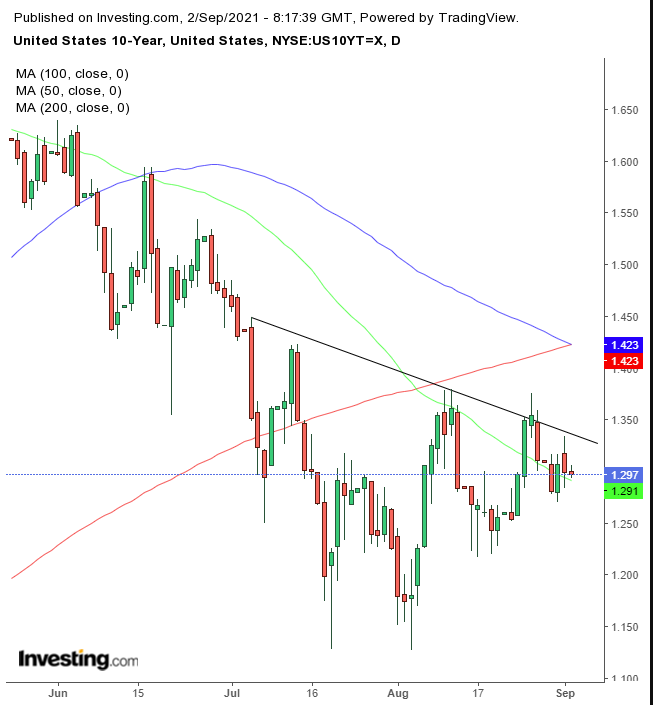
Perhaps after the NFP report, there will be resolution, or at least the beginning of one, with regard to the trend. Will it bottom along the development of the H&S, or will it resume its downtrend, as the Death Cross suggests?
The dollar tracked the decline in yields, falling for the ninth out of the last ten sessions.
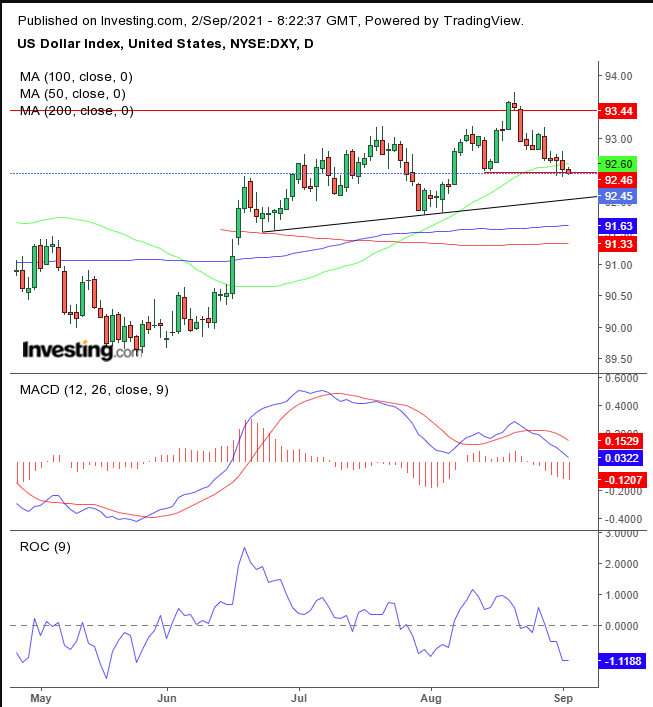
The greenback is edging to complete a small H&S top, which could lead to a larger one, having fallen away from the (red) neckline of a massive double bottom since November. The indicators appear bearish.
Gold traders also seem to be waiting on Friday's figures.
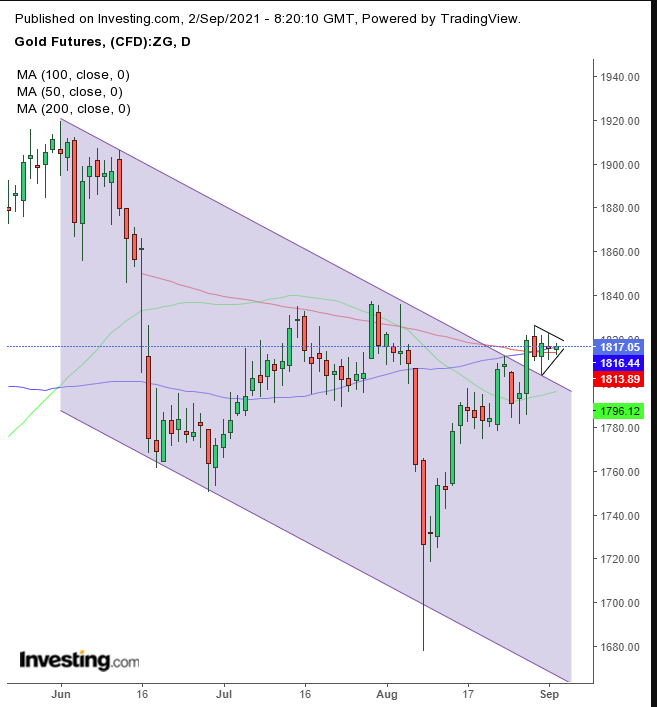
The price is stuck by the joint 100 and 200 DMA as it develops a potential bullish pennant, right on top of its previous falling channel.
Bitcoin climbed for the third straight day and even traded back above the key $50,000 level.
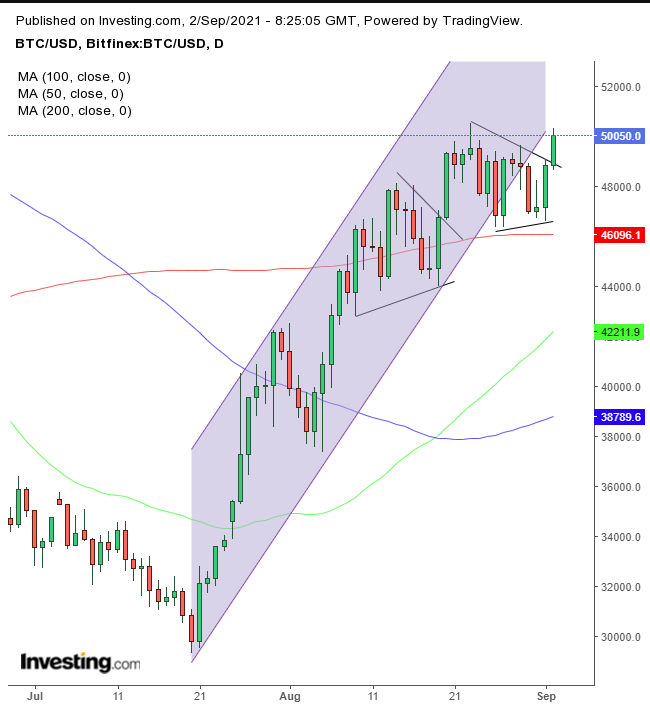
The cryptocurrency completed a back-to-back bullish pennant, with the second of the two supported by the 200 DMA, though bulls must demonstrate resolve by the potential resistance of the bottom of the broken rising channel.
Despite the markets expecting OPEC+ to confirm an output increase yesterday, oil slipped after the announcement. Recently, Kuwait's oil minister said that the group should reconsider raising production amid a worsening pandemic. Perhaps his comments removed the certainty of an increase which would explain why the price fell.
The production hike will offset the slide in US oil production after the recent hurricane in Louisiana caused significant dislocation to the US oil industry.
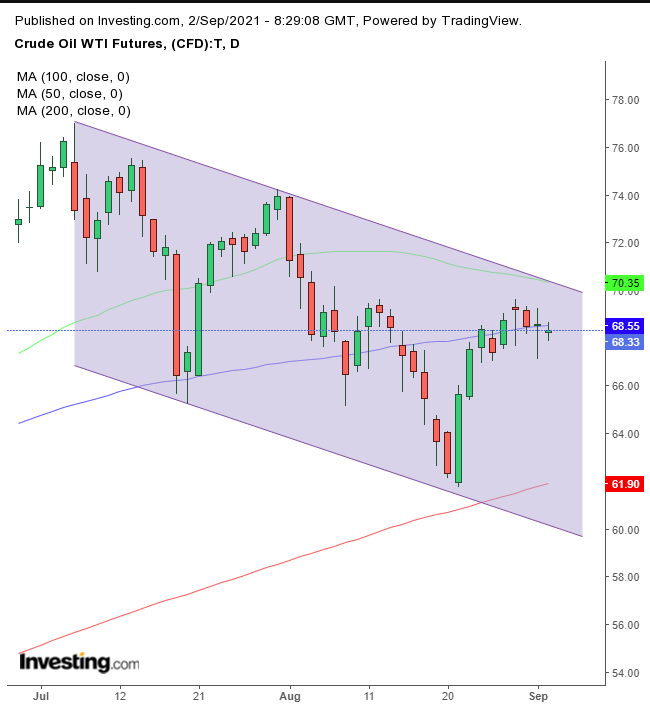
WTI's fall resumed the previous selloff, within a falling channel, reinforced by the 50 DMA. The price crossed below the 100 DMA while the 200 DMA supports the bottom of the channel with all moving averages perfectly spread out among the pressure points on the chart which provides a single, coherent picture.
Up Ahead
- On Friday the UK reports PMI figures.
- In Europe, retail sales figures for July are released on Friday.
- The US reports ISM non-manufacturing PMI for August on Friday.
Markets Move
Stocks
- The FTSE 100 is down 0.1%
- The STOXX 600 rose 0.3%
- Futures on the S&P 500 added almost 0.2%
- Futures on the NASDAQ 100 climbed nearly than 0.2%
- Futures on the Dow Jones Industrial Average gained almost 0.2%
Currencies
- The British pound gained over 0.1%
- The Dollar Index was declined less than 0.1%
- The euro was up 0.1%
- The Japanese yen was even
Bonds
- The yield on 10-year Treasuries was flat
- Germany’s 10-year yield declined 0.1 basis point
Commodities
- WTI edged lower 0.1%
- Spot gold rose less than 0.1%
